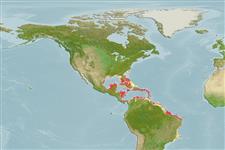Environment: milieu / climate zone / depth range / distribution range
Écologie
marin récifal; profondeur 0 - 33 m (Ref. 57883). Tropical
Western Central Atlantic: Bermuda, USA and northern Cuba. Sympatric with Ogilbia sabaji and O. suarezae along the shores of Florida,
Taille / Poids / Âge
Maturity: Lm ? range ? - ? cm
Max length : 6.0 cm SL mâle / non sexé; (Ref. 57883)
Description synthétique
Morphologie | Morphométrie
Rayons mous dorsaux (Total): 66-76; Rayons mous anaux: 50 - 57; Vertèbres: 39 - 41. Diagnosis: The species is characterized by the following: Vertebrae 11-13 + 27-29 = 39-41, dorsal fin rays 66-76, anal fin rays 50-57; outer and inner pseudoclaspers simple, triangular flaps, outer about 2 times size of inner pseudoclasper; penis tapering; opercular spine
with single, sharp tip; scale patch on cheeks with 4-6 vertical scale rows; otolith length: height ratio 2.1-2.3, sulcus not inclined; ventral fin reaching about 2/3 from ventral fin base to anal fin base (15.3-23.9, x = 20.3 % SL); body slender (13.2-17.4, x = 15.4 % SL) (Ref. 57883).
The species prefers shallow algae habitats at depths from 0 to 8 m, except for a single record off North Carolina (USNM 223537) caught at a depth of 31-33 m. A 44 mm SL female specimen (ANSP 148378) contained 2 embryos (12 mm TL) and 15 eggs (diameter 0.3 mm). A 37 mm SL female (ANSP 148378) contains 3 embryos of 8 mm TL, 1 embryo of 4 mm SL, and 10 eggs, 0.5 mm in diameter. The embryos have black eyes, but no pigmentation on head and body,
probably due to bleaching (Ref. 57883). A cryptic species, locally abundant (Ref. 34024).
Life cycle and mating behavior
Maturité | Reproduction | Frai | Œufs | Fécondité | Larves
Møller, P.R., W. Schwarzhans and J.G. Nielsen, 2005. Review of the American Dinematichthyini (Teleostei: Bythitidae). Part II. Ogilbia. aqua, J. Ichthyol. Aquat. Biol. 10(4):133-207. (Ref. 57883)
Statut dans la liste rouge de l'IUCN (Ref. 130435)
Menace pour l'homme
Harmless
Utilisations par l'homme
Pêcheries: sans intérêt
Plus d'informations
Noms communsSynonymesMétabolismePrédateursÉcotoxicologieReproductionMaturitéFraiRassemblement de ponteFéconditéŒufsDéveloppement de l'œuf
Taille/ÂgeCroissanceLongueur-poidsLongueur-longueurFréquences de longueursMorphométrieMorphologieLarvesDynamique des populations larvairesRecrutementAbondanceBRUVS
RéférencesAquacultureProfil d'aquacultureSouchesGénétiqueElectrophoresesHéritabilitéPathologiesTraitementNutrientsMass conversion
CollaborateursImagesStamps, Coins Misc.SonsCiguateraVitesseType de nageSurface branchialeOtolithesCerveauxVision
Outils
Articles particuliers
Télécharger en XML
Sources Internet
Estimates based on models
Preferred temperature (Ref.
123201): 24.9 - 28.2, mean 27.3 °C (based on 582 cells).
Phylogenetic diversity index (Ref.
82804): PD
50 = 0.5000 [Uniqueness, from 0.5 = low to 2.0 = high].
Bayesian length-weight: a=0.01000 (0.00244 - 0.04107), b=3.04 (2.81 - 3.27), in cm total length, based on all LWR estimates for this body shape (Ref.
93245).
Niveau trophique (Ref.
69278): 3.3 ±0.5 se; based on size and trophs of closest relatives
Résilience (Ref.
120179): Faible, temps minimum de doublement de population : 4,5 à 14 années (Assuming Fec < 100).
Fishing Vulnerability (Ref.
59153): Low vulnerability (10 of 100).
Nutrients (Ref.
124155): Calcium = 201 [106, 392] mg/100g; Iron = 1.06 [0.60, 1.87] mg/100g; Protein = 16.7 [14.1, 19.2] %; Omega3 = 0.124 [0.066, 0.230] g/100g; Selenium = 28 [13, 68] μg/100g; VitaminA = 128 [37, 446] μg/100g; Zinc = 2.74 [1.79, 3.96] mg/100g (wet weight);
